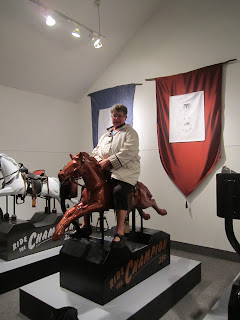
The English language wins again. I did learn that this little valley along the river was a favourite traditional spot for the local indigenous folk as it had good fishing/hunting and protected spots to hunker down in huts, during the winter. Warmer Chinook winds every once in a while helped them to get through the harsh Canadian winters.
Moose Jaw was a good spot to stop to camp for showers and to do laundry and see the old town's Underground Tunnels where
History Goes Underground. The tunnels are all under the streets in the old part of town under Main Street, down by the railway
station.

History Goes Underground. The tunnels are all under the streets in the old part of town under Main Street, down by the railway
station.


Al Capone, Public Enemy Number One in the USA and his goons and his guns and his gals, had a secret world under the streets of Moose Jaw during Liquor Prohibition in the States. They did rum-running by trains here and over the border to Chicago.  He died of syphillis and endured a long prison sentence mainly for tax evasion, but that is another story.
He died of syphillis and endured a long prison sentence mainly for tax evasion, but that is another story.
 He died of syphillis and endured a long prison sentence mainly for tax evasion, but that is another story.
He died of syphillis and endured a long prison sentence mainly for tax evasion, but that is another story.
That was a good slice of history to experience but the poignant history for me personally, was of the Chinese immigrants. It was the most amazing tour around the maze of underground spaces under the Main
Street businesses area. The racism above up on the streets kept them to themselves, basically slaves for the white supreme-owners that had bought their indentures from the 'coolie' traders, who asked thousands to even consider taking a "coolie" to North America.
The racism above up on the streets kept them to themselves, basically slaves for the white supreme-owners that had bought their indentures from the 'coolie' traders, who asked thousands to even consider taking a "coolie" to North America. 
Those Chinese immigrants hid under the Main Street, enduring intolerable conditions, to finally realize their dreams after saving a few pennies a day. They suffered from major depression down in those tunnels, which led to opium abuse, which was cheap then but also drained the few pennies they earned. It was really a form of slavery and oppression. However, a few saved for years and eventually started their own businesses. Their great-grandchildren are now our doctors and cancer research scientists. We must honour that tenacity and our common human drive for justice.
The Supreme Court of Canada has ruled in their favor several times in the last 50 years but we still read in the newspapers about discrimination. The Passage to Fortune tour was the better tour with the wonderful actors making the history come to life. The Chinese history on the prairies of Canada is a blot on our history of Human Rights.
Street businesses area.
 The racism above up on the streets kept them to themselves, basically slaves for the white supreme-owners that had bought their indentures from the 'coolie' traders, who asked thousands to even consider taking a "coolie" to North America.
The racism above up on the streets kept them to themselves, basically slaves for the white supreme-owners that had bought their indentures from the 'coolie' traders, who asked thousands to even consider taking a "coolie" to North America. 
Those Chinese immigrants hid under the Main Street, enduring intolerable conditions, to finally realize their dreams after saving a few pennies a day. They suffered from major depression down in those tunnels, which led to opium abuse, which was cheap then but also drained the few pennies they earned. It was really a form of slavery and oppression. However, a few saved for years and eventually started their own businesses. Their great-grandchildren are now our doctors and cancer research scientists. We must honour that tenacity and our common human drive for justice.
The Supreme Court of Canada has ruled in their favor several times in the last 50 years but we still read in the newspapers about discrimination. The Passage to Fortune tour was the better tour with the wonderful actors making the history come to life. The Chinese history on the prairies of Canada is a blot on our history of Human Rights.
And then a few days ago, I heard on the news : 2 asian workers brought in to work in the northern parts of Canada, died because they could not understand our safety rules and posted signs. They were being paid $600 a month personally but their wages were going to the worker-broker (coolie-trader) and were closer to $5000 a month. It is so much like what happened to blot our Canadian Human Rights record during the building of the cross-Canada railway. The 'Celestials" lives were considered to be expendable.
My Irish homesteader-ancestors have a plot there. So we pulled in to have lunch and so I could clean up my parents' area, while Old-Man-Watching had a nap. Above is my paternal mother's headstone. She died at 29 from spinal bone cancer.

My parents' china urns, which had red roses painted on them by my artist sister, are under this plaque that needed a good cleaning. The mud moves inward and the grass grows on the top of the slab of Audrey (Sutton) Fee and Roland Alonzo Burr Fee. Sigh and double sigh....as I will probably never get to clean this site again or sit here to meditate on a trip across Canada. Cemeteries are very peaceful places to have a prayer-time and or a nap.














































